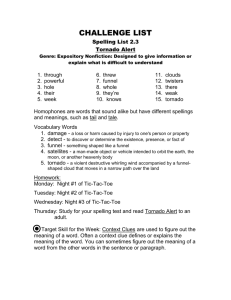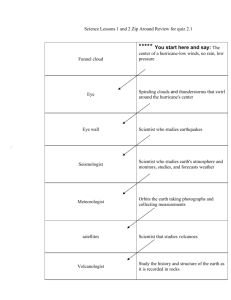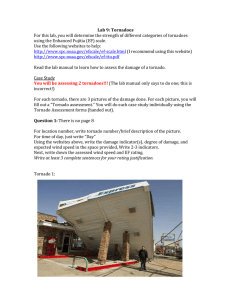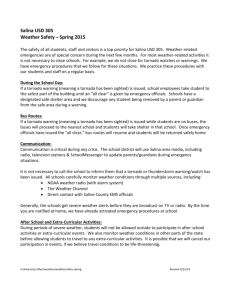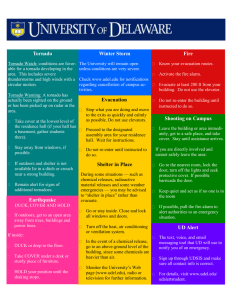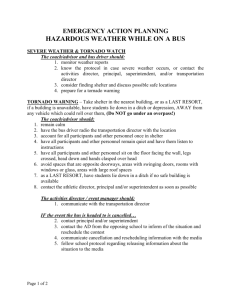Thematic Analysis of 30 Families Studied Post-Disaster Introduction Results
advertisement
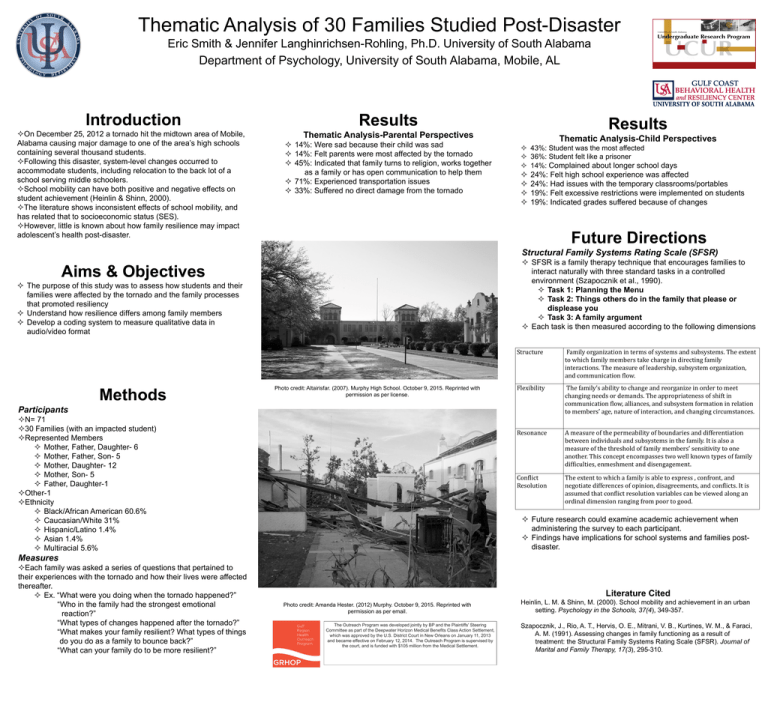
Thematic Analysis of 30 Families Studied Post-Disaster Eric Smith & Jennifer Langhinrichsen-Rohling, Ph.D. University of South Alabama Department of Psychology, University of South Alabama, Mobile, AL Introduction On December 25, 2012 a tornado hit the midtown area of Mobile, Alabama causing major damage to one of the area’s high schools containing several thousand students. Following this disaster, system-level changes occurred to accommodate students, including relocation to the back lot of a school serving middle schoolers. School mobility can have both positive and negative effects on student achievement (Heinlin & Shinn, 2000). The literature shows inconsistent effects of school mobility, and has related that to socioeconomic status (SES). However, little is known about how family resilience may impact adolescent’s health post-disaster. Results Results Thematic Analysis-Parental Perspectives 14%: Were sad because their child was sad 14%: Felt parents were most affected by the tornado 45%: Indicated that family turns to religion, works together as a family or has open communication to help them 71%: Experienced transportation issues 33%: Suffered no direct damage from the tornado Thematic Analysis-Child Perspectives 43%: Student was the most affected 36%: Student felt like a prisoner 14%: Complained about longer school days 24%: Felt high school experience was affected 24%: Had issues with the temporary classrooms/portables 19%: Felt excessive restrictions were implemented on students 19%: Indicated grades suffered because of changes Future Directions Structural Family Systems Rating Scale (SFSR) SFSR is a family therapy technique that encourages families to interact naturally with three standard tasks in a controlled environment (Szapocznik et al., 1990). Task 1: Planning the Menu Task 2: Things others do in the family that please or displease you Task 3: A family argument Each task is then measured according to the following dimensions Aims & Objectives The purpose of this study was to assess how students and their families were affected by the tornado and the family processes that promoted resiliency Understand how resilience differs among family members Develop a coding system to measure qualitative data in audio/video format Methods Photo credit: Altairisfar. (2007). Murphy High School. October 9, 2015. Reprinted with permission as per license. Structure Family organization in terms of systems and subsystems. The extent to which family members take charge in directing family interactions. The measure of leadership, subsystem organization, and communication flow. Flexibility The family’s ability to change and reorganize in order to meet changing needs or demands. The appropriateness of shift in communication flow, alliances, and subsystem formation in relation to members’ age, nature of interaction, and changing circumstances. Resonance A measure of the permeability of boundaries and differentiation between individuals and subsystems in the family. It is also a measure of the threshold of family members’ sensitivity to one another. This concept encompasses two well known types of family difficulties, enmeshment and disengagement. Conflict Resolution The extent to which a family is able to express , confront, and negotiate differences of opinion, disagreements, and conflicts. It is assumed that conflict resolution variables can be viewed along an ordinal dimension ranging from poor to good. Participants N= 71 30 Families (with an impacted student) Represented Members Mother, Father, Daughter- 6 Mother, Father, Son- 5 Mother, Daughter- 12 Mother, Son- 5 Father, Daughter-1 Other-1 Ethnicity Black/African American 60.6% Caucasian/White 31% Hispanic/Latino 1.4% Asian 1.4% Multiracial 5.6% Future research could examine academic achievement when administering the survey to each participant. Findings have implications for school systems and families postdisaster. Measures Each family was asked a series of questions that pertained to their experiences with the tornado and how their lives were affected thereafter. Ex. “What were you doing when the tornado happened?” “Who in the family had the strongest emotional reaction?” “What types of changes happened after the tornado?” “What makes your family resilient? What types of things do you do as a family to bounce back?” “What can your family do to be more resilient?” Literature Cited Photo credit: Amanda Hester. (2012) Murphy. October 9, 2015. Reprinted with permission as per email. The Outreach Program was developed jointly by BP and the Plaintiffs' Steering Committee as part of the Deepwater Horizon Medical Benefits Class Action Settlement, which was approved by the U.S. District Court in New Orleans on January 11, 2013 and became effective on February 12, 2014. The Outreach Program is supervised by the court, and is funded with $105 million from the Medical Settlement. Heinlin, L. M. & Shinn, M. (2000). School mobility and achievement in an urban setting. Psychology in the Schools, 37(4), 349-357. Szapocznik, J., Rio, A. T., Hervis, O. E., Mitrani, V. B., Kurtines, W. M., & Faraci, A. M. (1991). Assessing changes in family functioning as a result of treatment: the Structural Family Systems Rating Scale (SFSR). Journal of Marital and Family Therapy, 17(3), 295-310.
